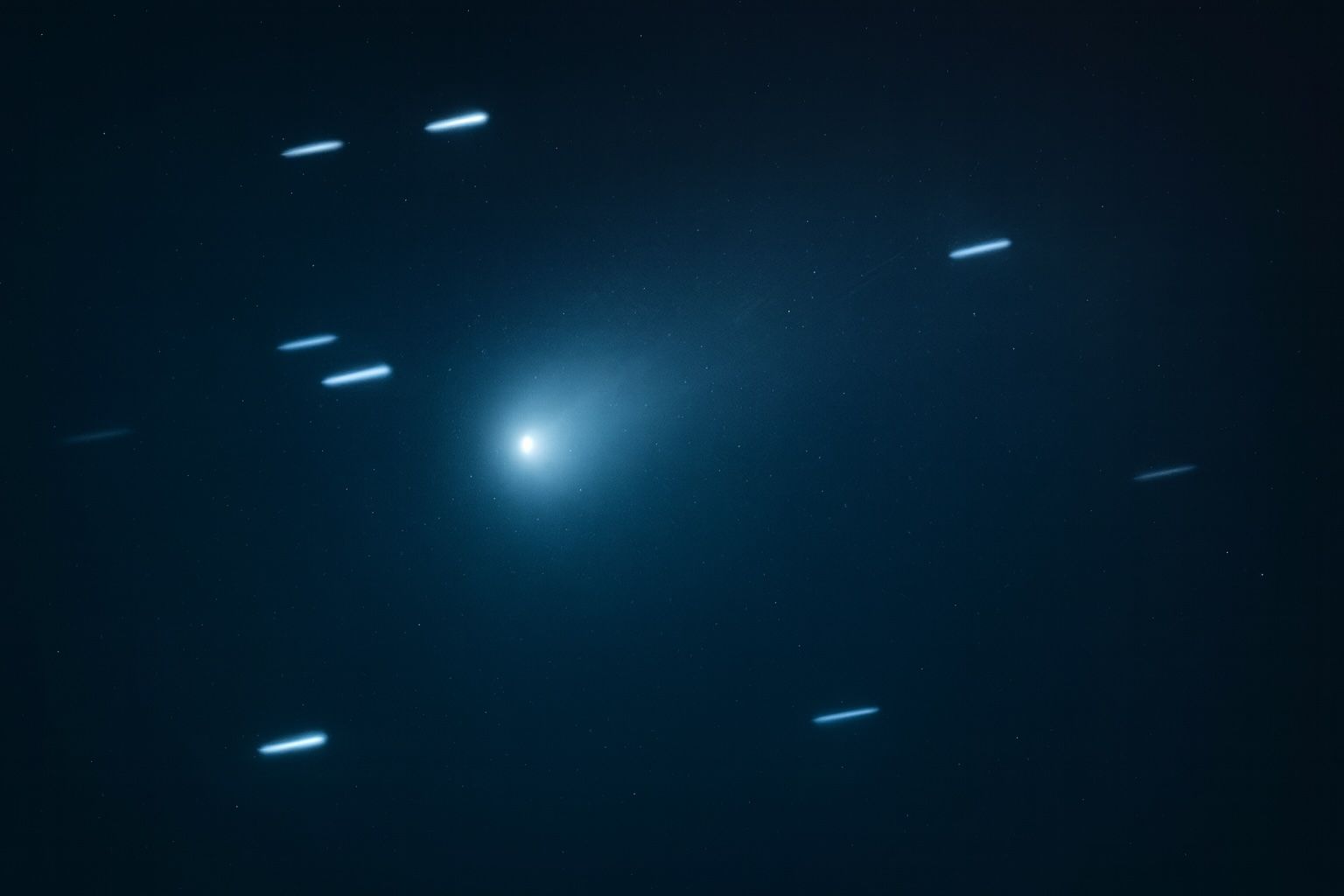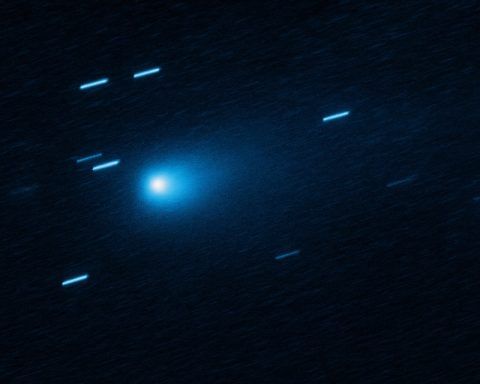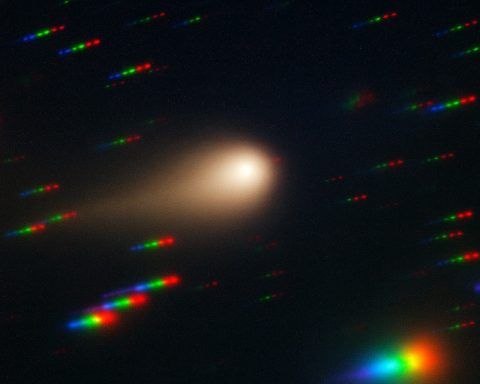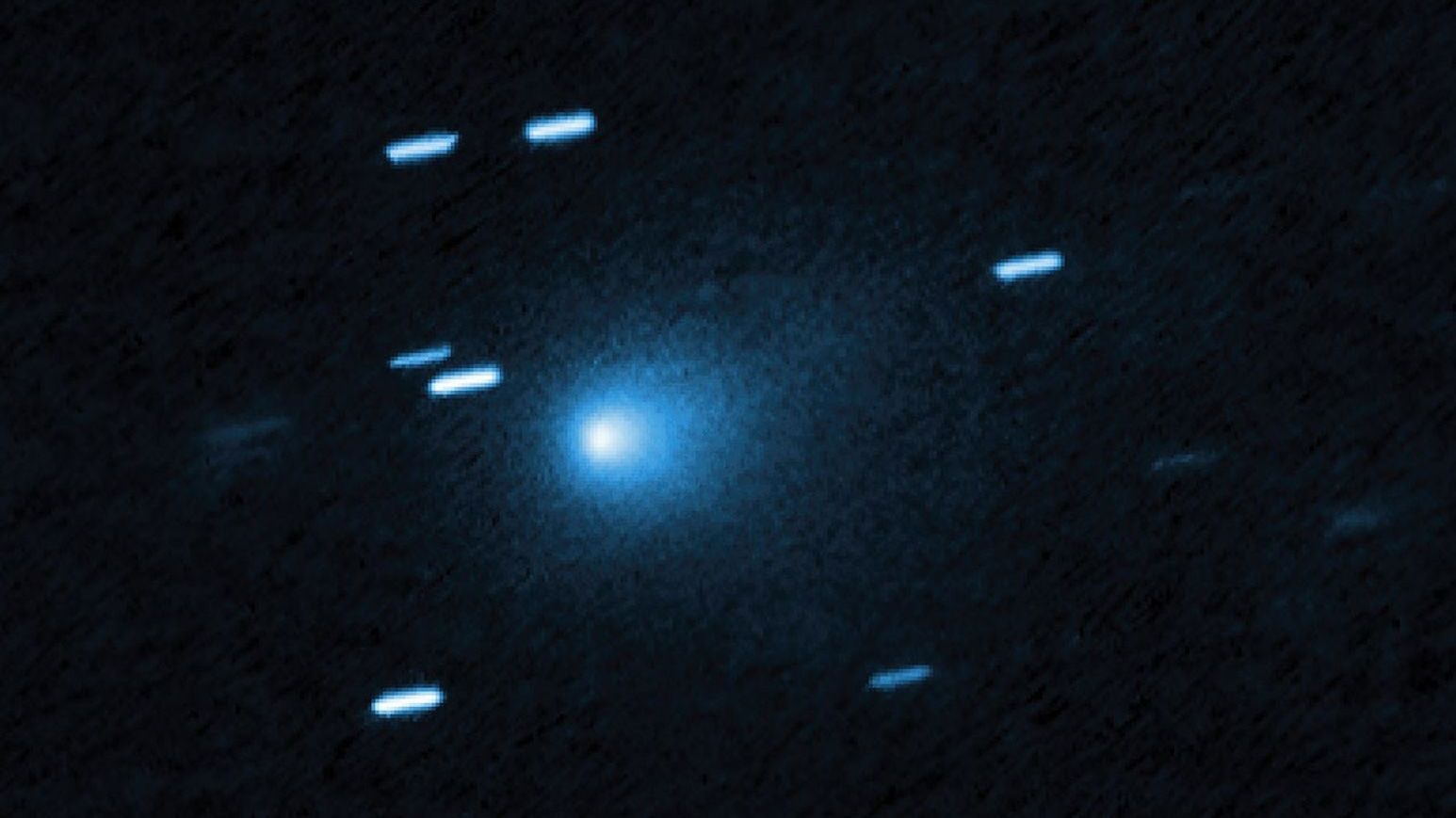Updated: 14 November 2025
Interstellar comet 3I/ATLAS has roared back into the headlines today, with new orbital data from Mars, a first detailed optical/IR portrait, political pressure on NASA over unreleased images, and yet another round of speculation about whether it might be an alien craft.
At the same time, guides published today show that 3I/ATLAS is finally creeping back into pre‑dawn view for Northern Hemisphere observers, though it will stay a telescopic target only. [1]
Here’s a clear, reality‑based look at what’s actually new on 14 November 2025, how you can observe this rare visitor, and why scientists are so excited about it.
1. Quick refresher: What is Comet 3I/ATLAS?
3I/ATLAS is the third known interstellar object to pass through our Solar System, after 1I/ʻOumuamua and 2I/Borisov. NASA classifies it as an interstellar comet because its orbit is clearly hyperbolic – it’s not bound to the Sun and will never return. [2]
Key facts from NASA’s latest overview and FAQ: [3]
- Discovery: Reported by the ATLAS survey telescope in Chile on 1 July 2025, with pre‑discovery images back to 14 June.
- Origin: Traced back to well beyond the Oort Cloud; its trajectory shows it came from outside the Solar System.
- Perihelion (closest to the Sun): Around 30 October 2025, at ~1.4 AU (about 130 million miles / 210 million km), just inside Mars’s orbit.
- Closest to Earth: Will be about 1.8 AU (~170 million miles / 270 million km) on 19 December 2025 – far beyond any impact concern.
- Size: Hubble data suggest an upper limit of ~3.5 miles (5.6 km) across; it could be as small as a few hundred meters. [4]
Composition‑wise, 3I/ATLAS looks very strange but still natural. Observations summarized this week show:
- An unusual chemistry, with lots of nickel, a high proportion of carbon dioxide, and relatively few common carbon‑chain molecules. [5]
- A red, dusty surface heavily processed by billions of years of cosmic‑ray bombardment, possibly making it older than the Solar System itself, with formation estimates reaching up to ~11 billion years. [6]
In other words: it’s weird, but “weird comet” weird, not “obviously alien” weird.
2. What’s new today – 14 November 2025?
Several significant 3I/ATLAS stories landed on 14 November. The biggest themes:
2.1 ESA sharpens 3I/ATLAS’s orbit using a spacecraft at Mars
The European Space Agency (ESA) released a major update today showing that it has improved the predicted path of 3I/ATLAS by about a factor of 10. [7]
How they did it:
- Between 1–7 October, the ExoMars Trace Gas Orbiter (TGO), normally focused on Mars, turned its camera toward 3I/ATLAS as the comet passed roughly 29 million km from Mars on 3 October. [8]
- Combining these Mars‑side measurements with Earth‑based observations allowed triangulation of the comet’s position and motion, sharply reducing the uncertainty in its future path. [9]
- Crucially, this is the first time that precise astrometric measurements from a spacecraft orbiting another planet have been officially submitted to, and accepted by, the Minor Planet Center for orbit refinement. [10]
Why it matters:
- 3I/ATLAS is racing through the Solar System at up to ~250,000 km/h (≈155,000 mph). [11]
- With a much tighter orbit, astronomers can point big telescopes more accurately in the brief windows when the comet is visible, maximizing precious JWST, Hubble, radar, and radio time. [12]
- ESA frames this as a planetary‑defence rehearsal: in a real threat scenario, precisely this sort of “multi‑vantage” tracking from Earth and other planets or spacecraft would be crucial. [13]
Even though NASA and ESA already agreed that 3I/ATLAS poses no danger, the exercise shows how Mars‑ or Jupiter‑orbiting spacecraft could help nail down orbits for future near‑Earth threats. [14]
2.2 First detailed optical/IR study: a dusty, complex, interstellar surface
Also out today is an AZoOptics report on a new paper in The Astrophysical Journal Letters providing the earliest detailed optical and near‑infrared characterization of 3I/ATLAS. [15]
Using the NASA Infrared Telescope Facility (IRTF) in Hawaii with its SpeX spectrograph and the ʻOpihi imager, researchers measured how the comet reflects sunlight from 0.7 to 2.5 microns. Their key findings: [16]
- The spectrum is moderately red at visible wavelengths – it reflects more light at longer (redder) wavelengths.
- Beyond ~0.9 microns, the spectrum curves and flattens, even becoming neutral or slightly blue in the near‑IR.
- There are no clear absorption bands that would normally reveal abundant water ice, silicates, or common organics.
- Simple “Solar‑System‑like” dust models don’t fit; the data are best explained by:
- Lots of very small dust grains, or
- Dust with unusual composition or structure, or both.
The authors conclude that 3I/ATLAS’s coma and surface are likely dominated by complex organic material and refractory dust, with any water ice signatures masked or scarce. [17]
This reinforces the broader theme from ESA, NASA, and ScienceAlert: everything we’re seeing is consistent with a comet – just one formed in a very different stellar nursery. [18]
2.3 US politics and Mars images: will NASA release “missing” 3I/ATLAS shots?
Another story published today by International Business Times highlights how 3I/ATLAS has wandered into US politics. [19]
Key points:
- A 43‑day US government shutdown has just ended, restoring funding for NASA and other agencies through at least January 30. [20]
- Rep. Anna Paulina Luna (R‑Florida) sent an open letter to acting NASA administrator Sean Duffy, publicly demanding the release of:
- Images of 3I/ATLAS taken by the HiRISE camera on the Mars Reconnaissance Orbiter on 2–3 October.
- Supplemental data from Perseverance and any other Mars missions that might have seen the comet during its Mars flyby. [21]
- Luna argues the data are vital for understanding interstellar visitors and says NASA should also prioritize follow‑up observations from missions like Juno when 3I/ATLAS passes near Jupiter in 2026. [22]
The article also notes that China’s Tianwen‑1 orbiter has already released its own images from the comet’s October flyby of Mars, while NASA has not yet published its equivalent shots. [23]
So far, there is no evidence of NASA hiding anything sinister; the delay is consistent with long processing and calibration pipelines, especially during a shutdown. The pressure mainly highlights how hyper‑online speculation is driving political attention.
2.4 “Alien mothership?” New headlines vs scientific pushback
3I/ATLAS continues to generate viral stories claiming it might be an alien spacecraft:
- An IBTimes piece today leans into the idea that the lack of debris after perihelion could mean an “alien mothership,” quoting some of Harvard astrophysicist Avi Loeb’s more speculative comments that assign a ~30–40% chance the object is artificial. [24]
- The same article cites a study by David Jewitt and Jane Luu, who actually report that 3I/ATLAS has not fragmented and appears as an intact nucleus with a normal‑looking coma, even after its close pass to the Sun. [25]
Meanwhile, scientists have been very busy rebutting the alien narrative:
- A new blog post today by astronomer Jason Wright of Penn State bluntly titled “3I/ATLAS is Still Intact and Still a Comet” explains that Loeb’s tail‑energy calculations are fundamentally wrong. He notes that Loeb treats the tail as gas confined by the solar wind, when in reality comet tails are largely dust pushed by solar radiation pressure, which changes the physics entirely. [26]
- A ScienceAlert feature published yesterday similarly concludes that every line of evidence so far supports a natural comet, even if its nickel and CO₂ abundances are unusual. The article points out that Loeb’s list of “anomalies” boils down to a handful of odd but still comet‑like properties. [27]
- Earlier this week, a Live Science report on the first radio detection from 3I/ATLAS using the MeerKAT array in South Africa showed that the so‑called “signal” is just hydroxyl (OH) absorption produced when solar UV splits water in the comet’s coma—exactly what you’d expect from a very active comet near perihelion. [28]
Taken together, the mainstream scientific consensus as of 14 November is:
3I/ATLAS is a highly unusual but entirely natural interstellar comet, with no credible evidence of artificial origin.
2.5 Fresh guidance on how to see 3I/ATLAS in November–December
A new observing guide from The Economic Times today compiles advice from several astronomy outlets, including EarthSky and BBC Sky at Night. [29]
Highlights:
- Brightness: Forecast to hover around magnitude 10–12 in mid‑November and December – far fainter than the naked‑eye limit (~mag 6). It will never be visible without optical aid. [30]
- Current position (mid‑November):
- In the constellation Virgo, low in the east–southeast before dawn for mid‑northern latitudes. [31]
- December path:
- Drifts northward into Leo, passing near the bright star Regulus later in the month. [32]
- Telescope requirements:
- Visual observers are advised to use at least an 8‑inch (20 cm) telescope under dark skies. Sky & Telescope similarly warns you’ll need a scope capable of seeing an 11th–12th‑magnitude “faint fuzzy” low in the pre‑dawn sky. [33]
- Photography:
- A phone camera alone won’t cut it. You’ll need long‑exposure astrophotography on a tracking mount, or a modern “smart telescope” that automatically stacks many 30–120 second frames. [34]
Apps such as Stellarium, SkySafari, and NASA’s Eyes on the Solar System are recommended to get an exact, real‑time position from your location. [35]
3. Where is 3I/ATLAS right now, and how bright is it?
Pulling together today’s guides and live‑data services: [36]
- Constellation: Currently Virgo, emerging from solar glare into the pre‑dawn sky for mid‑northern observers.
- Altitude: Around 15–20° above the horizon just before the start of dawn around November 16 for ~40°N latitude; slightly lower today but improving each morning. [37]
- Magnitude: Estimates cluster around mag 10–11 this week, with some services listing ~9.6 and others closer to 11–12; real‑world observers are generally reporting a faint, diffuse comet. [38]
Because the comet is low in twilight and faint, sky conditions are critical:
- Only attempt it from a dark site with a clear, unobstructed eastern horizon.
- Let your eyes dark‑adapt and use averted vision (looking slightly to the side of the comet’s position).
- Expect a small glow with a short tail in visual eyepieces – the big dramatic tails you see online are usually the result of heavy image processing and stacking. [39]
4. Is 3I/ATLAS dangerous for Earth?
Short answer: No. Not remotely.
NASA’s official page is explicit:
- Closest approach to Earth: about 1.8 AU (~170 million miles / 270 million km) on 19 December 2025.
- That’s well beyond the orbit of Earth and comfortably outside any impact scenario. [40]
ESA’s new orbit, refined using Mars‑side data, only strengthens this conclusion: the path is now known more precisely, and none of the updated trajectories come anywhere near Earth. [41]
Some viral posts have also confused 3I/ATLAS with a completely different body: comet C/2025 K1 (ATLAS), sometimes dubbed the “other comet ATLAS.” That one is passing much closer to Earth (~37 million miles on 25 November) but is a local Solar‑System comet, not interstellar, and has actually broken apart into a cloud of debris. [42]
3I/ATLAS, by contrast, is staying in one piece at a great distance and remains a scientific curiosity, not a hazard. [43]
5. 3I/ATLAS vs the “other” Comet ATLAS: don’t mix them up
To reduce confusion:
- 3I/ATLAS (C/2025 N1)
- Interstellar, hyperbolic orbit.
- Perihelion: ~30 October 2025 at ~1.4 AU.
- Closest to Earth: 19 December at ~1.8 AU.
- Intact nucleus with active coma and tail. [44]
- C/2025 K1 (ATLAS) – “other comet ATLAS”
Both comets carry the “ATLAS” label simply because they were discovered by the ATLAS survey, not because they’re physically connected in any way.
6. Why scientists are so excited about 3I/ATLAS
Beyond the media drama, 3I/ATLAS is a gold mine for planetary science:
- It offers a direct sample of material from another star system – and quite possibly from the early, outer regions of the Milky Way, based on kinematic modeling and its extremely irradiated, nickel‑rich composition. [47]
- The new IRTF study suggests dust and organics that don’t match standard Solar‑System comet models, hinting at different planet‑formation chemistry in its home system. [48]
- ESA’s Mars‑based triangulation demonstrates a new technique for orbit refinement that could be invaluable for future planetary‑defence efforts. [49]
- Ongoing and planned observations from Hubble, JWST, SPHEREx, Mars orbiters, and eventually the Juno spacecraft near Jupiter will build a uniquely complete multi‑wavelength, multi‑vantage dataset for a single interstellar object. [50]
The combination of weird chemistry + interstellar origin + unprecedented coverage is exactly why astronomers are determined to squeeze every photon out of this brief encounter.
7. How to observe 3I/ATLAS in the coming weeks
Here’s a consolidated, practical viewing plan based on today’s guides and ephemerides: [51]
Mid–late November 2025
- When: About 60–90 minutes before local sunrise.
- Where in the sky:
- Low in the east–southeast, in Virgo.
- Around Nov 16–20, ~20° above the horizon from ~40°N just as astronomical twilight begins.
- What you need:
- At least an 8‑inch telescope; larger apertures strongly preferred.
- A detailed chart or app (Stellarium, SkySafari, NASA Eyes) to nail down its exact position.
December 2025 (including closest approach to Earth)
- General trend:
- The comet climbs higher and moves northward into Leo, making evening observations possible from some locations.
- Close approach:
- 19 December 2025, at 1.8 AU from Earth – still faint, but better placed in the sky. [52]
Visual expectations
- Don’t expect a “Great Comet”. You’re looking for a dim, diffuse patch with a small, subtle tail.
- Under good conditions and with enough aperture, you may notice the coma and inner tail structure, but most of the spectacular images online are long stacked exposures with heavy contrast stretching. [53]
8. FAQ: 3I/ATLAS today
Can I see 3I/ATLAS with the naked eye?
No. Its peak brightness is magnitude 10–12, far below the naked‑eye limit even under perfect dark skies. You need a telescope and dark conditions. [54]
Is 3I/ATLAS going to hit Earth, or even come close?
No. Its closest approach is about 1.8 AU from Earth on 19 December 2025, according to NASA and ESA – comfortably distant and now even more precisely constrained. [55]
So what about the radio “signal” and “no debris” stories?
The radio signal detected by the MeerKAT telescope is hydroxyl (OH) absorption, produced when sunlight breaks apart water in the comet’s coma – a classic sign of normal cometary outgassing. [56]
The “no debris” narrative refers to the fact that, unlike some comets, 3I/ATLAS has not broken apart after perihelion. Observers like Jewitt and Luu report it remains a single, active nucleus with a typical coma and tail, which is unusual but not unprecedented. [57]
Could 3I/ATLAS still be an alien spacecraft?
There’s no observational evidence supporting an artificial origin. The “alien mothership” idea comes from a speculative minority view; every major observational result to date is consistent with a comet. Mainstream comet specialists have publicly dismantled the claimed “anomalies.” [58]
References
1. m.economictimes.com, 2. science.nasa.gov, 3. science.nasa.gov, 4. science.nasa.gov, 5. www.sciencealert.com, 6. www.sciencealert.com, 7. www.esa.int, 8. www.esa.int, 9. www.esa.int, 10. www.esa.int, 11. www.esa.int, 12. www.esa.int, 13. www.esa.int, 14. science.nasa.gov, 15. www.azooptics.com, 16. www.azooptics.com, 17. www.azooptics.com, 18. www.sciencealert.com, 19. www.ibtimes.co.uk, 20. www.ibtimes.co.uk, 21. www.ibtimes.co.uk, 22. www.ibtimes.co.uk, 23. www.ibtimes.co.uk, 24. www.ibtimes.co.uk, 25. www.ibtimes.co.uk, 26. sites.psu.edu, 27. www.sciencealert.com, 28. www.livescience.com, 29. m.economictimes.com, 30. m.economictimes.com, 31. m.economictimes.com, 32. m.economictimes.com, 33. m.economictimes.com, 34. m.economictimes.com, 35. m.economictimes.com, 36. m.economictimes.com, 37. skyandtelescope.org, 38. m.economictimes.com, 39. m.economictimes.com, 40. science.nasa.gov, 41. www.esa.int, 42. www.livescience.com, 43. www.ibtimes.co.uk, 44. science.nasa.gov, 45. www.livescience.com, 46. www.livescience.com, 47. www.sciencealert.com, 48. www.azooptics.com, 49. www.esa.int, 50. science.nasa.gov, 51. m.economictimes.com, 52. science.nasa.gov, 53. m.economictimes.com, 54. m.economictimes.com, 55. science.nasa.gov, 56. www.livescience.com, 57. www.ibtimes.co.uk, 58. sites.psu.edu










